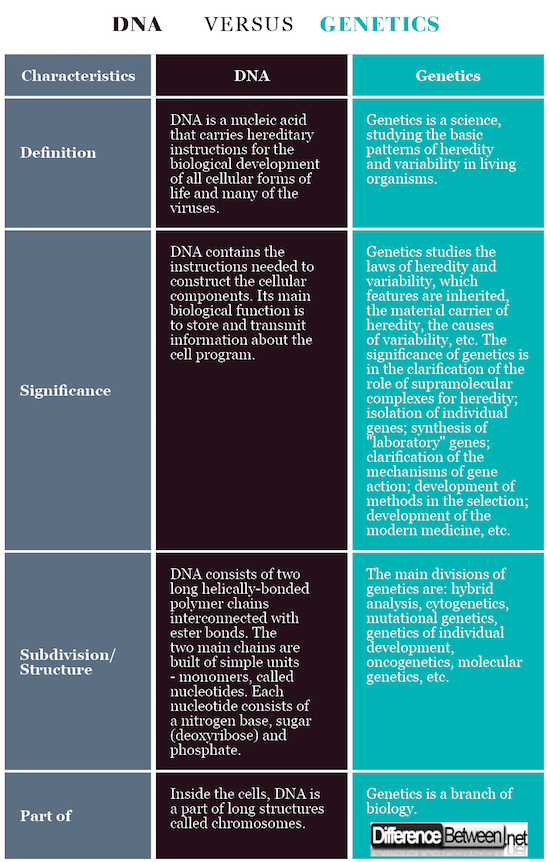Difference Between DNA and Genetics
What is DNA?
Deoxyribonucleic acid (DNA) is a nucleic acid that carries hereditary instructions for the biological development of all cellular forms of life and many viruses. DNA contains the instructions needed to construct the cellular components. Its main biological function is to store and transmit information.
Nucleic acids are stable, but at the same time variable molecules, both structurally and chemically. Only the combination of stability and some variability can provide for the complex biological functions of nucleic acids.
Segments of the DNA molecule carrying genetic information are called genes. There are other DNA sequences that perform structural functions or participate in regulating the use of genetic information.
DNA consists of two long helically-bonded polymer chains interconnected with ester bonds. The DNA molecules in the cells are in the form of double helices. The two main chains are built of simple units – monomers, called nucleotides. Nucleotides consist of a nitrogen base, sugar (deoxyribose) and phosphate. The nitrogen bases are four types: adenine (A), guanine (G), cytosine (C) and thymine (T). The skeleton of the two chains is located towards outside, and the nitrogen bases are directed towards the inside of the filament.
The linking of the two helices is done by the rule of complementarity of the bases – always (A) of one chain is connected to (T) of the other chain. Accordingly, always (G) connects to (C). Thus, aligning the bases in one chain of the DNA molecule determines the alignment of the bases in the other.
The sequence of the four nucleobases along the main chain serves to encode the information. It is read by a genetic code that defines the sequence of amino acids in the proteins. The code is read by copying sites of DNA into the similar nucleic acid RNA in a process called transcription.
Inside the cells, DNA forms long structures called chromosomes. Before the cells divide, the chromosomes are doubled by the replication process. Eukaryotic organisms store the bulk of their DNA inside the cell nucleus. A smaller part is located in organelles such as mitochondria or chloroplasts. Prokaryotes (archaea and bacteria) store their DNA only in the cytoplasm. Inside the chromosomes, chromatin proteins, such as histones, serve to organize DNA and direct the interaction of DNA with other proteins by participating in transcriptional control.

What is Genetics?
Genetics is a science, a branch of biology, studying the basic patterns of heredity and variability in living organisms.
Heredity ensures that the similarities and differences between organisms in the generations are preserved. Variability ensures changes in some characteristics, as a result of the genetic information or changes in the environment. From these two properties of living organisms depends the adaptation to various environmental conditions and improvement in the way of evolution.
The name of genetics originates from the Greek word “genea”, which means “origin”. The main concepts in genetics are the gene, genotype, and phenotype. The man begins to apply his knowledge of genetics in ancient history in the cultivation and reproduction of plants and animals. In modern research, genetics provides important tools for studying the functions of individual genes, analysis of genetic interactions, etc. In organisms, genetic information is primarily found in chromosomes in the form of DNA sequences.
The main task of genetics is to study the laws of heredity and variability, which features are inherited, the material carrier of heredity, the causes of variability, etc.
Genetics uses diverse research methods:
- Hybrid (genetic) analysis;
- Genealogical method;
- Cytogenetical method;
- Populational method;
- Biochemical method;
- Physiological method;
- Mutation method;
- Biometric (mathematical) method, etc.
Genetics is of great importance for both theory and practice. The significance of genetics is in:
- Clarification of the role of supramolecular complexes for heredity;
- Isolation of individual genes;
- Synthesis of “laboratory” genes;
- Clarification of the mechanisms of gene action;
- Development of methods in the selection;
- Development of the modern medicine, etc.
The main divisions of genetics are:
- Hybrid analysis;
- Cytogenetics;
- Mutational genetics;
- Genetics of individual development;
- Oncogenetics;
- Molecular genetics, etc.
Difference Between DNA and Genetics
-
Definition of DNA Vs. Genetics
DNA: DNA is a nucleic acid that carries hereditary instructions for the biological development of all cellular forms of life and many of the viruses.
Genetics: Genetics is a science, studying the basic patterns of heredity and variability in living organisms.
-
Significance of DNA Vs. Genetics
DNA: DNA contains the instructions needed to construct the cellular components. Its main biological function is to store and transmit information about the cell program.
Genetics: Genetics studies the laws of heredity and variability, which features are inherited, the material carrier of heredity, the causes of variability, etc. The significance of genetics is in the clarification of the role of supramolecular complexes for heredity; isolation of individual genes; synthesis of “laboratory” genes; clarification of the mechanisms of gene action; development of methods in the selection; development of the modern medicine, etc.
-
Subdivision/Structure
DNA: DNA consists of two long helically-bonded polymer chains interconnected with ester bonds. The two main chains are built of simple units – monomers, called nucleotides. Each nucleotide consists of a nitrogen base, sugar (deoxyribose) and phosphate.
Genetics: The main divisions of genetics are: hybrid analysis, cytogenetics, mutational genetics, genetics of individual development, oncogenetics, molecular genetics, etc.
-
Part of
DNA: Inside the cells, DNA is a part of long structures called chromosomes.
Genetics: Genetics is a branch of biology.
Difference between DNA and Genetics: Tabular form

Summary of of DNA Vs. Genetics
- DNA is a nucleic acid that carries hereditary instructions for the biological development of all cellular forms of life and many of the viruses. It is stable, but at the same time variable, both structurally and chemically. Only the combination of stability with some variability can provide for the complex biological functions of DNA.
- Genetics is a science, studying the basic patterns of heredity and variability in living organisms. From these two properties of living organisms depends adaptation to various environmental conditions and improvement in the way of evolution.
- DNA contains the instructions needed to construct the cellular components. Its main biological function is to store and transmit information about the cell program.
- Genetics is of great importance for both theory and practice. It studies the laws of heredity and variability, which features are inherited, the material carrier of heredity, the causes of variability, etc.
- DNA consists of two long helically-bonded polymer chains interconnected with ester bonds. The two main chains are built of simple units – monomers, called nucleotides. Each nucleotide consists of a nitrogen base, sugar (deoxyribose) and phosphate.
- The main divisions of genetics are: hybrid analysis, cytogenetics, mutational genetics, genetics of individual development, oncogenetics, molecular genetics, etc.
- Inside the cells, DNA is a part of long structures called chromosomes.
- Genetics is a branch of biology.
- Difference Between Gallstones and Cholecystitis - September 5, 2021
- Difference Between Constipation and Cramping - August 4, 2021
- Difference Between Whole Genome Sequencing and Microarray - May 6, 2021
Search DifferenceBetween.net :
Leave a Response
References :
[0]Ayala, J. and J. Kiger. Modern Genetics. San Francisco: Benjamin-Cummings Publishing Company. 1989. Print.
[1]Klug, W. and M. Cummings. Concepts of Genetics (6th Edition). 1999. Print.
[2]Stubs, M. and N. Suleyman. Cell biology and genetics. China: Elsevier. 2013. Print.
[3]Image credit: https://www.publicdomainpictures.net/pictures/50000/velka/dna-1370603787LgY.jpg
[4]Image credit: https://upload.wikimedia.org/wikipedia/commons/thumb/9/9b/Genetics_-_The_Noun_Project.svg/500px-Genetics_-_The_Noun_Project.svg.png

